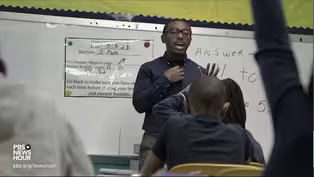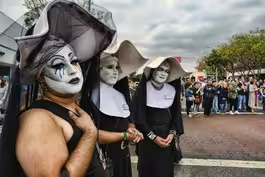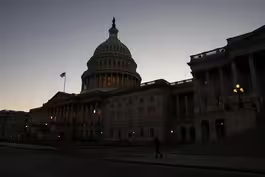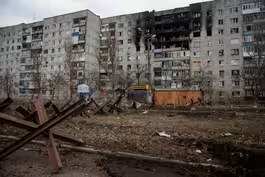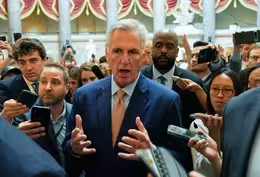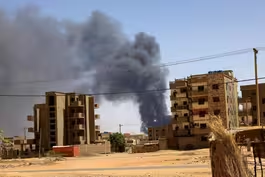
Artist uses architecture of Guggenheim in new installation
Clip: 5/23/2023 | 5m 49sVideo has Closed Captions
Artist Sarah Sze uses architecture of Guggenheim Museum as part of her new installation
At New York’s Guggenheim Museum, you can walk around and into artwork by Sarah Sze. Photos, videos, objects, sounds and light are things in our daily lives. All of it is material for Sze, an artist who takes the information overload and gives it a new shape and order. Jeffrey Brown takes a look for our arts and culture series, CANVAS.
Problems playing video? | Closed Captioning Feedback
Problems playing video? | Closed Captioning Feedback
Major corporate funding for the PBS News Hour is provided by BDO, BNSF, Consumer Cellular, American Cruise Lines, and Raymond James. Funding for the PBS NewsHour Weekend is provided by...

Artist uses architecture of Guggenheim in new installation
Clip: 5/23/2023 | 5m 49sVideo has Closed Captions
At New York’s Guggenheim Museum, you can walk around and into artwork by Sarah Sze. Photos, videos, objects, sounds and light are things in our daily lives. All of it is material for Sze, an artist who takes the information overload and gives it a new shape and order. Jeffrey Brown takes a look for our arts and culture series, CANVAS.
Problems playing video? | Closed Captioning Feedback
How to Watch PBS News Hour
PBS News Hour is available to stream on pbs.org and the free PBS App, available on iPhone, Apple TV, Android TV, Android smartphones, Amazon Fire TV, Amazon Fire Tablet, Roku, Samsung Smart TV, and Vizio.
Providing Support for PBS.org
Learn Moreabout PBS online sponsorshipWILLIAM BRANGHAM: Photos, videos, objects, sounds, and light, the myriad stuff, both real and virtual, in our daily lives, it's all the material for Sarah Sze, an artist who takes this information overload and gives it a new shape.
Jeffrey Brown takes a look for our arts and culture series, Canvas.
JEFFREY BROWN: At New York's Guggenheim Museum right now, you can walk around and into an artwork by Sarah Sze and be taken by more than a few surprises.
Is this your studio ladder?
SARAH SZE, Artist: I know.
I didn't -- that wasn't on purpose, but I didn't peel it off.
We didn't have time.
JEFFREY BROWN: Oh, so, studio ladder, pliers, house plant.
SARAH SZE: Yes.
Yes.
Yes.
JEFFREY BROWN: I mean, I can just go on and on.
SARAH SZE: Yes.
Yes.
JEFFREY BROWN: But anything goes, in a sense?
SARAH SZE: So, anything goes, but everything is necessary.
JEFFREY BROWN: In art terms, these works or installations or sculptures.
More colorfully, some have seen an exploded hardware store or the contents of an iPhone spilled out into space, all the millions of images in our lives turned into objects, pieces of constructions that may hold together, but may break apart.
SARAH SZE: I like dismantling the artwork and having it seep into the architecture, the audience seep into each other.
So these boundaries, these frames, they get blurred, because I think that's the way we're experiencing life.
We can walk down the street and watch a movie.
So, we're looking up at the sky, and then we're looking down and then we're seeing a person.
And so that intersection of the way we experience time, the way we experience space is changing.
And I'm interested in how we mark what is important, what is meaningful with this new language.
JEFFREY BROWN: The exhibition is titled Timelapse.
And, in some works, like one called Timekeeper, the references to marking time are over, a metronome, clocks in different cities set amid a kind of giant science experiment of objects, small projectors, videos, sounds, lights.
There's a different way to experience time in Times Zero, a large abstract painting, and a strange mirror version of it cut into pieces and reassembled beneath the original.
Everywhere you turn in her work, images of images, it might be on our screens, on our walks, or in our heads.
SARAH SZE: The number of images that are around us is -- becomes -- the volume on that is turned so high that the images that are in our head, which happen while we're dreaming, while we're imagining what we're hoping, when I look at you, I can picture like seeing you on television.
That's in my head.
So I'm seeing these images at the same time.
Interior images are being merged all the time with exterior images.
So that's something I'm interested in people thinking about.
JEFFREY BROWN: Sze, now 54, grew up in Boston, her Chinese-born father an architect, her mother a schoolteacher.
She's received a MacArthur fellowship, represented the U.S. at the 2013 Venice Biennale, completed major commissions in public spaces such as New York's La Guardia Airport and High Line Park, and is exhibited in museums around the world.
At the Guggenheim, she's created site-specific works that play off and with Frank Lloyd Wright's landmark architectural spiral, the curved bays where art is exhibited, and the sloping ramps that can disorient viewers.
SARAH SZE: You can see actually how off-balance we are.
Usually, things like this would be covered up in the museum, but I wanted you to really see like this is the first step to leveling a piece.
So you can really understand that even your body is always at an angle at this space.
JEFFREY BROWN: And then, when you move around - - and so we see the -- we see the construction.
SARAH SZE: Exactly.
It's not hidden.
Nothing is hidden.
JEFFREY BROWN: She's also offered new sight lines of the spectacular oculus at the top of the dome, and hung a pendulum that descends to a small fountain in the atrium.
And she's filled the space with everyday objects, including appliances, materials you're more likely to find at Home Depot or in your own home than in a museum.
SARAH SZE: I think of material as a palette, a palette of daily life, and... JEFFREY BROWN: A palette of daily life.
SARAH SZE: I'm interested in the line being blurred between what's outside the museum and in the museum.
So you start to see the artistry in the world.
JEFFREY BROWN: So why do you like that?
I mean, why are you seeking that?
SARAH SZE: I think it's the way we experience life.
There isn't a boundary.
It isn't framed, to marry the everyday experience with the profound.
So, for me, many things, I'm interested in having something very profound happening next to something very, very, very mundane.
So you can look up and see a volcano go, and then you can look down and you can just see a piece of paint on the floor, and that you should shift between those things,because I do you think a lot of our moments of profundity or moments of joy come at times we least expect.
JEFFREY BROWN: I mean, the other obvious question is, how do you know when it's finished?
SARAH SZE: Right.
JEFFREY BROWN: How do you know when you're done?
SARAH SZE: For me, when it's done is when it's right at the edge of feeling like it's coming together, but it could also fall apart.
It's this teetering moment of change.
We're always in that moment, right?
We're somewhere in between.
We have -- time is finite for us.
We know that.
And to highlight, to make that moment of presence really powerful as you stand in front of something is, I think -- is, for me, what -- why I am so interested in seeing art.
Artwork is always -- it's a time traveler.
It's a capsule.
It tells us what it means to be human both in the past, in the present, and potentially what it might be like in the future.
JEFFREY BROWN: Sarah Sze's Timelapse exhibition is up through September 10.
For the "PBS NewsHour," I'm Jeffrey Brown at the Guggenheim Museum in New York.
Black teachers counteract dropout rate among Black students
Video has Closed Captions
Clip: 5/23/2023 | 6m 40s | Organization mentors Black teachers to counteract dropout rate among Black students (6m 40s)
Dodgers re-invite drag group to Pride Night after backlash
Video has Closed Captions
Clip: 5/23/2023 | 7m 16s | Los Angeles Dodgers re-invite satirical drag group to Pride Night after backlash (7m 16s)
How the U.S. national debt reached $31.4 trillion
Video has Closed Captions
Clip: 5/23/2023 | 5m 43s | How the U.S. national debt reached $31.4 trillion (5m 43s)
The human toll of the battle for Bakhmut in eastern Ukraine
Video has Closed Captions
Clip: 5/23/2023 | 3m 46s | The human toll of the battle for Bakhmut in eastern Ukraine (3m 46s)
The potential impacts of the U.S. defaulting on its debt
Video has Closed Captions
Clip: 5/23/2023 | 6m 8s | Economist Mark Zandi on the potential impacts of the U.S. defaulting on its debt (6m 8s)
Tenuous ceasefire in Sudan offers some needed relief
Video has Closed Captions
Clip: 5/23/2023 | 5m 46s | Tenuous ceasefire in Sudan offers some needed relief after weeks of brutal fighting (5m 46s)
Uvalde still seeking accountability a year after shooting
Video has Closed Captions
Clip: 5/23/2023 | 5m 28s | Uvalde community still seeking accountability a year after elementary school shooting (5m 28s)
Providing Support for PBS.org
Learn Moreabout PBS online sponsorship
- News and Public Affairs

FRONTLINE is investigative journalism that questions, explains and changes our world.

- News and Public Affairs

Amanpour and Company features conversations with leaders and decision makers.












Support for PBS provided by:
Major corporate funding for the PBS News Hour is provided by BDO, BNSF, Consumer Cellular, American Cruise Lines, and Raymond James. Funding for the PBS NewsHour Weekend is provided by...
